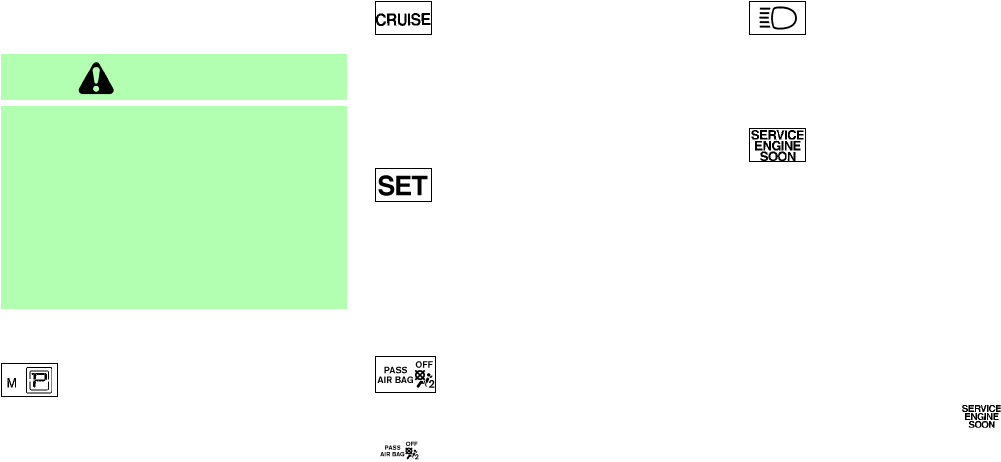
seat belts and supplemental restraint system”
section.
WARNING
If the supplemental air bag warning
light is on, it could mean that the
supplemental front air bag, supplemen-
tal side air bag, curtain side-impact air
bag systems and/or pre-tensioner seat
belt systems will not operate in an acci-
dent. To help avoid injury to yourself or
others, have your vehicle checked by a
NISSAN dealer as soon as possible.
INDICATOR LIGHTS
Automatic transmission
position indicator light (A/T
models)
When the ignition key is turned to the ON
position, the indicator in the tachometer shows
the automatic transmission selector lever posi-
tion. See “Driving the vehicle” (automatic trans-
mission) in the “5. Starting and driving” section.
Cruise main switch indicator
light (if so equipped)
The light comes on when the cruise control main
switch is pushed. The light goes out when the
main switch is pushed again. When the cruise
main switch indicator light comes on, the cruise
control system is operational.
Cruise set switch indicator
light (if so equipped)
The light comes on while the vehicle speed is
controlled by the cruise control system. If the
light blinks while the engine is running, it may
indicate the cruise control system is not func-
tioning properly. Have the system checked by a
NISSAN dealer.
Front passenger air bag status
light
The front passenger air bag status light
(
) will be lit and the passenger front air bag
will be OFF depending on how the front passen-
ger seat is being used.
For front passenger air bag status light opera-
tion, see “NISSAN advanced air bag system” in
the “1. Safety — Seats, seat belts and supple-
mental restraint system” section of this manual.
High beam indicator light
(Blue)
This light comes on when the headlight high
beam is on and goes out when the low beam is
selected.
Malfunction indicator lamp
(MIL)
If the malfunction indicator lamp (MIL) comes on
steady or blinks while the engine is running, it
may indicate a potential emission control mal-
function.
The malfunction indicator lamp may also come
on steady if the fuel-filler cap is loose or missing,
or if the vehicle runs out of fuel. Check to make
sure the fuel-filler cap is installed and closed
tightly, and that the vehicle has at least 3 US
gallons (14 liters) of fuel in the fuel tank.
After a few driving trips, the
lamp should
turn off if no other potential emission control
system malfunction exists.
If this indicator lamp comes on steady for 20
seconds and then blinks for 10 seconds when
the engine is not running, it indicates that the
vehicle is not ready for an emission control
system inspection/maintenance test. See
“Readiness for inspection/maintenance (I/M)
test” in the “9. Technical and consumer informa-
2-16 Instruments and controls
੬ 06.7.20/Z33-D/V5.0 ੭


















